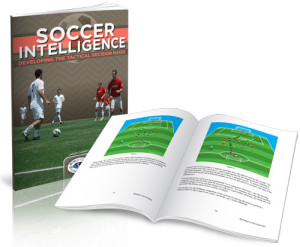Soccer is a 'Player Centered' game. The players make the decisions as the game is played. Unlike our traditional American sports of football, baseball and basketball. In those sports the players rely heavily on the coaches for direction and decision making. The coaches call the play, give the sign for a certain pitch or run an in-bounds play that the team has worked on at practice.
By contrast, soccer is a free flowing, constantly changing game where the players have to decide what to do based on where they are, where their team mates are and where the opponents are at any given moment. There are no time outs and few stoppages that allow the coach to directly effect the play. The players must have the ability to read the situation, make a decision and then effectively execute the necessary skills. That's a lot to ask of a seven year old, isn't it.?
Maybe that's why you can go to any soccer field on a weekend in the spring and you will all to often see a coach playing what I call, 'Nintendo Soccer'. The coach is trying to direct the movements of each player while telling the player with the ball exactly what to do with it. The players aren't, 'playing' as much as they are just moving to the commands of the conductor.
Thankfully, most coaches would identify this type of micro management as over coaching. Unfortunately it is still more common that it should be.
We must teach our young players to think for themselves if they are to reach their potential as players. This means that right from the start, U6, U7 and U8, we must allow the players to think and act for themselves. It doesn't have to be chaotic 'bunch ball'. We can do this by giving them a framework of understanding and the freedom to experiment within that framework. The decisions at first are simple. You can break it down by when we have the ball and when we don't.
When We Have the Ball
- The player with the ball needs to shoot if he can, pass if someone is in a better position than him or try to beat the defender with a move
- His team mates need to find open space where there is a clear path to the ball,; no defenders in the way
When We Don't Have the Ball
- The closest player pressures the ball and stays in front of it while the other players cover for hit
It doesn't have to be any more complicated that this. The coach can now spend his time teaching the players the skills of the game and end every training session with a game where he can use the skills from the session and reinforce the decisions the players make when they have the ball and when they don't.
When the players make mistakes the coach can talk to the players about the choices they made and what they can do next time to get a different result. But the key is that the coach must allow the player to make the decision and only give them feedback after the fact. The game will also give the players feedback that they can learn from. If they lose the ball they will often recognize that they made a mistake and they may even quickly realize what they could have done to avoid it. If they don't then it's the job of the coach to help them see the correct decision so that they may make a different choice next time.
As the players progress then the level of thought and decision making becomes more complex but the basic principles stay the same: give them a framework and allow them to make the decisions.
This type of learning is not a new concept. It's just that it's a messy process and it's so much quicker to just tell Johnny to, 'Pass it down the line!' Johnny might not know why he's passing it but the short term result is a completed pass that moves the team forward and that's good enough for now.
We must give our players the tools they need to be successful but then allow them to use those tools to create something that is truly theirs.
We have a great new book that focuses on developing, 'Soccer Intelligence'. It includes drills, exercises and small-sided games that will help teach your players to think and act for themselves.
Check this book out for great training ideas.
Have a great day!
Tom



